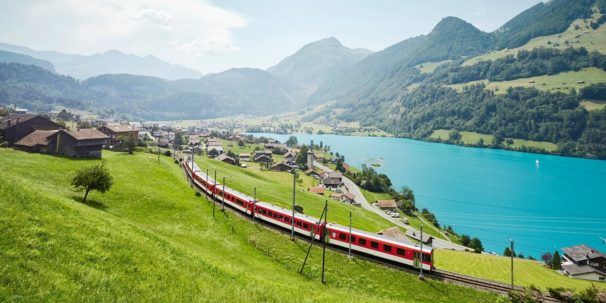What is sustainable tourism and why is it important?
In this article, we explore the benefits and drawbacks of the tourism industry, explore the role of sustainable tourism and ecotourism, and offer some examples.

By Rhiannon Wardle
Tourism is a huge part of our global culture, allowing us to explore different parts of the world, meet people from different walks of life, and experience new traditions and activities. Since it brings many benefits to both travellers and communities, it can generally be seen as a force for good.
However, the industry is changing. As the years go by, we’re becoming more and more aware of the threat of climate change and our role in escalating it. Across all industries, our global community is thinking about ways we can lessen our impact on the earth.
A study published in 2018 by Nature Climate Change suggested that tourism accounts for 8% of global greenhouse gas emissions, which is a very large percentage when we consider all of the possible sources of emissions. For this reason, it’s clear that we need to move towards a more sustainable tourism model, and that’s why we’re having this discussion today.
In this article, we’ll offer definitions of sustainable tourism and ecotourism, discuss the pros and cons of the tourism industry, explore how sustainable tourism could offer a solution to our current challenges, and finish with some examples of sustainable tourism.
What’s the definition of sustainable tourism?
Sustainable tourism can be defined as a kind of tourism that has more benefits than negative impacts, especially relating to the environment, the economy and communities. Truly sustainable and responsible tourism should make destinations better for people to live in as well as visit.
If you’re interested in this topic, you can learn more about the planning and development of tourism activities in our International Culture and Tourism Management ExpertTrack by Nankai University. You’ll also discover strategies for sustainable tourism management.
The main responsibilities of sustainable tourism include:
-
- Protecting the environment, natural resources, and wildlife
- Providing socio-economic benefits for communities who live in tourist destinations
- Conserving cultural heritage and creating authentic tourist experiences
- Bringing tourists and local communities together for mutual benefit
- Creating inclusive and accessible tourist opportunities.
Ecotourism vs sustainable tourism
You may have heard the terms ecotourism and sustainable tourism being used interchangeably. Although both are important, there is a slight difference between what they mean.
While sustainable tourism is about creating travel opportunities with minimal impact and positive benefits for destinations and their communities, ecotourism is more focused on educating tourists about nature and the environment, and travellers taking part in conservation and cultural activities.
While ecotourism should always be sustainable, not all examples of sustainable tourism are ecotourism. For example, you might take a train to stay in a sustainably powered lodge. While this is a sustainable option, you’re not necessarily learning about nature and your local surroundings in an educational sense.
For a more detailed look at ecotourism, you can take a look at our open step from Coventry University and find a definition from the United Nations World Tourism Organization (UNWTO).
Facts about the tourism industry
Before we delve more into the impact of the tourism industry, let’s explore some recent facts and figures so that we have a better sense of the current situation. On their website, Sustaining Tourism state that international tourist arrivals have increased from 25 million in 1950 to 1.32 billion in 2017.
They also state that travel and tourism made up 10% of total GDP in 2016, and the average international tourist receipt is over 700 US dollars per person. Therefore, it’s clear that tourism has a huge economic impact on communities, and the industry is continuing to grow at a staggering rate.
For an in-depth and detailed look into the tourism industry today, our The Impacts of Tourism course by Coventry University will tackle all the issues we’re discussing today and more.
What are the positive impacts of the tourism industry?
There are a few main ways we can look at the positive impacts of the tourism industry. We can start by looking at the social and cultural benefits, before moving on to study the environmental benefits. This will provide us with some well-rounded insights into different key areas.
Social and cultural benefits of tourism
- Strengthened communities due to more money and resources
- Improved infrastructure including buildings and transport systems
- Higher rates of employment due to the tourism industry
- Improved understanding of different cultures and traditions
- Preservation of local cultures
- Commercialisation of art and culture
- Conservation of heritage including architecture and natural sites
- Increased number of events and celebrations
Environmental benefits of tourism
- Creation of natural parks and Areas of Outstanding Natural Beauty
- Reduced numbers of animal poaching
- Improved water quality
- Increased funding for nature conservation and protection
What are the negative impacts of the tourism industry?
It’s not all positives, unfortunately. Otherwise, there wouldn’t be such a need for sustainable tourism and ecotourism. Once again, we’ll split these negative impacts into the social and cultural impacts and the environmental impacts of tourism.
Negative social and cultural impacts of tourism
The negative socio-cultural impacts of tourism can vary heavily depending on location and culture, but there are definitely some patterns that repeatedly show themselves. Our open step by Coventry University suggests three things that can happen:
- Staged authenticity: This refers to when events or cultures are manufactured just to bring in tourism and money, even when they don’t reflect the local culture of destination communities. This can cause bad feelings between tourists and locals, and can also lead to the eradication of local culture.
- Standardisation: Often tourists seek familiarity even when they are visiting a foreign country, and this can lead to a loss of cultural diversity. For example, you can find McDonald’s and Starbucks all around the world, and these huge companies can take business from smaller companies.
- Commodification: In some ways, this is similar to staged authenticity, because it happens when tourism destroys the true meaning of cultural performances, events and customs. Instead, they are transformed to suit the time frames and wishes of tourists. Understandably, this can make local communities feel taken advantage of and disrespected.
Negative environmental impacts of tourism
As discussed in our open step by Coventry University, there are two main ways that tourism can negatively impact the environment: through the development of the area, or through the behaviour of tourists. Some examples of both include:
Development of the area
- Damage of wild habitats due to new infrastructure
- Weakened resilience to natural disasters
- Beautiful scenery ruined by hotels and car parks
- Deforestation
- Overuse of water due to influx of people
Behaviour of tourists
- Air pollution due to traffic congestion
- Destruction of nature due to littering and disregard
- Wildlife relocating due to increased noise levels
- Higher consumption of energy
- Plastic pollution in the ocean affecting sealife




How sustainable tourism is providing a solution
It’s not just local communities that live in tourist destinations that are feeling the negative effects of tourism. As tourists ourselves, many of us prefer to visit places that are clean, not too crowded, and safe. We also usually want to preserve local cultures, traditions, religions, and buildings, rather than experience an inauthentic ploy for money.
Therefore, we all have a lot to gain from alternative forms of tourism, including sustainable forms. The best places for sustainable tourism to be developed are regions with natural resources, landscapes, or cultural buildings – all features that attract tourists who might want to explore and admire local destinations and cultures in an environmentally friendly way.
You can learn more about what makes a tourist destination so attractive in our Placemaking and Public Space Design: Unlocking Tourist Destinations course by the Lulea University of Technology.
The goals of sustainable tourism
The World Tourism Organization and the United Nations Environment Program suggested twelve main goals for sustainable tourism in 2005. These will help to demonstrate the ways in which sustainable tourism can provide a solution to some of the global challenges facing the industry today:
- Economic Viability: To make sure that tourism destinations and businesses are viable, competitive, and able to achieve long-term success.
- Local Prosperity: To ensure that tourism activities help local communities thrive economically and retain a large amount of the economic contribution.
- Employment Quality: To increase the number of local jobs created in the tourism industry and ensure that the pay and working conditions are fair, safe and offered to workers without discrimination.
- Social Equity: To ensure that tourism increases the amount of economic and social benefits being distributed across local communities, improving all areas of life.
- Visitor Fulfillment: To create a safe and fulfilling holiday experience for tourists without discrimination based on race, gender, sexuality, disability or other.
- Local Control: To empower local communities to have a role in planning and decision-making regarding tourism in their neighbourhoods.
- Community Wellbeing: To improve the quality of life and wellbeing of local communities, ensuring they have access to resources and are not disrespected or exploited in the name of tourism.
- Cultural Richness: To respect the cultural heritage, traditions, authenticity and uniqueness of host communities.
- Physical Integrity: To look after all landscapes, whether urban or rural, and ensure that they are not degraded physically or visually as a result of tourism.
- Biological Diversity: To conserve natural areas, wildlife, and unique habitats, protecting them and ensuring they are not damaged.
- Resource Efficiency: To use sustainable and renewable resources when possible in the development and operation of tourism facilities and services.
- Environmental Purity: To protect the land, air and water from pollution, littering and other waste that may come as a result of tourism businesses or visitors.
What are some examples of sustainable tourism?
There are plenty of different examples of sustainable tourism, but the main thing you need to do before you plan a sustainable trip is making sure you’ve done your research. While one aspect of a trip may seem sustainable, it’s worth considering the holiday in its entirety before you solidify any plans.
One example of sustainable tourism is the Six Senses Fiji resort, which is powered solely on solar power, recycles rainwater, runs on a low-waste model, and uses handiwork such as furnishings and artwork created by local villagers.
However, this is obviously a high-budget type of experience. For something simple, how about organising a self-sufficient camping trip, choosing sites accessible by train or bike? Or if you’re looking for something more wildlife-focused, how about looking for a sustainable conservation program abroad?
Rural tourism
One kind of sustainable tourism is rural tourism, which you can read about in more detail in our open step by Coventry University. It must occur outside of an urban environment and tends to focus on actively participating in a rural lifestyle. With rural tourism, tourists tend to stay with local people, understand their lifestyles, and even help out with manual labour.
While rural tourism is more of a branch of ecotourism, by nature, it’s normally pretty sustainable. This is because it helps to support local people, focuses on the rural environment, and doesn’t involve vast numbers of tourists all being in the same place at once.
Community tourism
In a similar vein, community tourism can also be a great example of sustainable tourism. This is because it’s at the opposite end of the spectrum to mass tourism. Normally, local residents and communities invite tourists to stay with them, and they may offer different events, activities and experiences.
While this could be similar to rural tourism, it doesn’t have to focus on natural surroundings. Instead, the purpose of community tourism is more about empowering local communities to plan, implement and be responsible for tourism activities in their home destinations. While they will gain economic benefits, tourists will enjoy authentic experiences.
Final thoughts
Hopefully, this has enlightened you on the importance of sustainable tourism in our current society. The tourism industry is by no means a bad thing, but there are so many opportunities for it to develop and grow into something that is beneficial for tourists, local communities, and the planet, all at the same time.
Plus, if you’re interested in a career in sustainable tourism, we have an excellent Master of Business Administration (Sustainable Tourism) degree from Coventry University. If you join, you’ll become an expert in contemporary sustainable tourism principles and practices.










